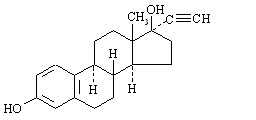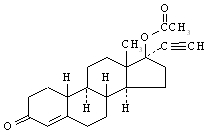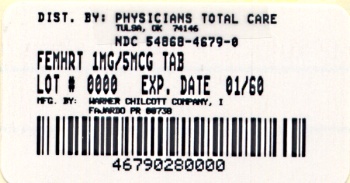Femhrt
Generic name: ethinyl estradiol and norethindrone (HRT)
Drug classes: Contraceptives, Sex hormone combinations
Medically reviewed by A Ras MD.
What is Femhrt?
Femhrt is a prescription medicine that contains two kinds of hormones, an estrogen and a progestin.
Femhrt is used after menopause to reduce moderate to severe hot flushes
Estrogens are hormones made by a woman’s ovaries. The ovaries normally stop making estrogens when a woman is between 45 and 55 years old. This drop in body estrogen levels causes the “change of life” or menopause, the end of monthly menstrual periods. Sometimes both ovaries are removed during an operation before natural menopause takes place. The sudden drop in estrogen levels causes “surgical menopause”.
When estrogen levels begin dropping, some women get very uncomfortable symptoms, such as feelings of warmth in the face, neck, and chest, or sudden intense episodes of heat and sweating (“hot flashes” or “hot flushes”). In some women the symptoms are mild, and they will not need to take estrogens. In other women, symptoms can be more severe.
- Help reduce your chances of getting osteoporosis (thin weak bones)
If you use Femhrt only to prevent osteoporosis from menopause, talk with your healthcare provider about whether a different treatment or medicine without estrogens might be better for you. You and your healthcare provider should talk regularly about whether you still need treatment with Femhrt.
Description
femhrt® (norethindrone acetate/ethinyl estradiol tablets) is a continuous dosage regimen of a progestin-estrogen combination for oral administration.
The following two strengths of femhrt tablets are available:
femhrt (0.5 mg/2.5 mcg): Each white oval tablet contains 0.5 mg norethindrone acetate and 2.5 mcg ethinyl estradiol.
femhrt (1 mg/5 mcg): Each white D-shaped tablet contains 1 mg norethindrone acetate and 5 mcg ethinyl estradiol.
Each tablet also contains the following inactive ingredients: calcium stearate, lactose monohydrate, microcrystalline cellulose, and cornstarch.
The structural formulas are as follows:

Ethinyl Estradiol [19-Norpregna-1,3,5(10)-trien-20-yne-3,17-diol, (17α)-]
Molecular Weight: 296.41
Molecular Formula: C20H24O2

Norethindrone Acetate [19-Norpregn-4-en-20-yn-3-one, 17-(acetyloxy)-, (17α)-]
Molecular Weight: 340.47
Molecular Formula: C22H28O3
What is the most important information I should know about Femhrt?
- Do not use estrogens with progestins to prevent heart disease, heart attacks, strokes or dementia (decline of brain function).
- Using estrogens with progestins may increase your chances of getting a heart attack, strokes, breast cancer, or blood clots.
- Using estrogens with progestins may increase your chance of getting dementia, based on a study of women 65 years of age or older.
- Do not use estrogen-alone to prevent heart disease, heart attacks, strokes or dementia.
- Using estrogen-alone may increase your chance of getting cancer of the uterus (womb).
- Using estrogen-alone may increase your chances of getting strokes or blood clots.
- Using estrogen-alone may increase your chance of getting dementia, based on a study of women 65 years of age or older.
- You and your healthcare provider should talk regularly about whether you still need treatment with Femhrt
Who should not take Femhrt?
Do not take Femhrt if you have had your uterus (womb) removed (hysterectomy).
Femhrt contains a progestin to decrease the chance of getting cancer of the uterus. If you do not have a uterus, you do not need a progestin and you should not take Femhrt.
Do not take Femhrt if you:
- have unusual vaginal bleeding
Vaginal bleeding after menopause may be a warning sign of cancer of the uterus (womb). Your healthcare provider should check any unusual vaginal bleeding to find out the cause. - currently have or have had certain cancers.
Estrogens may increase the chance of getting certain types of cancers, including cancer of the breast or uterus. If you have or have had cancer, talk with your healthcare provider about whether you should take Femhrt. - had a stroke or heart attack
- currently have or have had blood clots
- currently have or have had liver problems
- have been diagnosed with a bleeding disorder
- are allergic to Femhrt or any of its ingredients.
See the list of ingredients in Femhrt at the end of this leaflet. - think you may be pregnant
Femhrt is not for pregnant women. If you think you may be pregnant, you should have a pregnancy test and know the results. Do not take Femhrt if the test is positive and talk to your healthcare provider.
What should I tell my healthcare provider before taking Femhrt?
Before you take Femhrt, tell your healthcare provider if you:
- have any unusual vaginal bleeding
Vaginal bleeding after menopause may be a warning sign of cancer of the uterus (womb). Your healthcare provider should check any unusual vaginal bleeding to find out the cause. - have any other medical conditions
Your healthcare provider may need to check you more carefully if you have certain conditions, such as asthma (wheezing), epilepsy (seizures), diabetes, migraine, endometriosis, lupus, angioedema (swelling of face and tongue), or problems with your heart, liver, thyroid, kidneys, or have high calcium levels in your blood. - are going to have surgery or will be on bed rest
Your healthcare provider will let you know if you need to stop taking Femhrt. - are breastfeeding
The hormones in Femhrt can pass into your breast milk.
Tell your healthcare provider about all the medicines you take, including prescription and non-prescription medicines, vitamins, and herbal supplements. Some medicines may affect how Femhrt works. Femhrt may also affect how your other medicines work. Keep a list of your medicines and show it to your healthcare provider and pharmacist when you get a new medicine.
How should I take Femhrt?
- Take femhrt exactly as your healthcare provider tells you to take it.
- Take 1 femhrt tablet at the same time each day.
- You and your healthcare provider should talk regularly (every 3 to 6 months) about the dose you are taking and whether or not you still need treatment with femhrt.
What are the possible side effects of Femhrt?
Side effects are grouped by how serious they are and how often they happen when you are treated.
Serious, but less common side effects include:
- heart attack
- stroke
- blood clots
- dementia
- breast cancer
- cancer of the lining of the uterus (womb)
- cancer of the ovary
- high blood pressure
- high blood sugar
- gallbladder disease
- liver problems
- changes in your thyroid hormone levels
- enlargement of benign tumors of the uterus (“fibroids”)
Call your healthcare provider right away if you get any of the following warning signs or any other unusual symptoms that concern you:
- new breast lumps
- unusual vaginal bleeding
- changes in vision or speech
- sudden new severe headaches
- severe pains in your chest or legs with or without shortness of breath, weakness and fatigue
Less serious, but common side effects include:
- headache
- breast pain
- irregular vaginal bleeding or spotting
- stomach or abdominal cramps, bloating
- hair loss
- fluid retention
- vaginal yeast infection
These are not all the possible side effects of Femhrt. For more information, ask your healthcare provider or pharmacist. Tell your healthcare provider if you have any side effects that bother you or does not go away.
You may report side effects to Allergan at 1-800-678-1605 or FDA at 1-800-FDA-1088.
What can I do to lower my chances of a serious side effect with Femhrt?
- Talk with your healthcare provider regularly about whether you should continue taking Femhrt.
- If you have a uterus, talk with your healthcare provider about whether the addition of a progestin is right for you.
- The addition of a progestin is generally recommended for a woman with a uterus to reduce the chance of getting cancer of the uterus (womb).
- See your healthcare provider right away if you develop vaginal bleeding while taking Femhrt.
- Have a pelvic exam, breast exam and mammogram (breast x-ray) every year unless your healthcare provider tells you something else.
- If members of your family have had breast cancer or if you have ever had breast lumps or an abnormal mammogram (breast x-ray), you may need to have breast exams more often.
- If you have high blood pressure, high cholesterol (fat in the blood), diabetes, are overweight, or use tobacco, you may have a higher chance for getting heart disease.
Ask your healthcare provider for ways to lower your chances of getting heart disease.
General information about the safe and effective use of Femhrt
Medicines are sometimes prescribed for conditions that are not mentioned in patient information leaflets. Do not take Femhrt for conditions for which it was not prescribed. Do not give Femhrt to other people, even if they have the same symptoms you have. It may harm them.
This leaflet summarizes the most important information about Femhrt. If you would like more information, talk with your healthcare provider or pharmacist. You can ask your pharmacist or healthcare provider for information about Femhrt that is written for health professionals.
For more information go to www.femhrt.com or call 1-800-678-1605.
How should I store Femhrt?
Store Femhrt at room temperature between 68° F to 77° F (20° C to 25° C).
Keep Femhrt out of the reach of children.
What are the ingredients in Femhrt?
Active Ingredients: norethindrone acetate and ethinyl estradiol
Inactive Ingredients: calcium stearate, lactose monohydrate, microcrystalline cellulose and corn starch
Label
FEMHRT – 1 MG/5 MCG


SRC: NLM .
